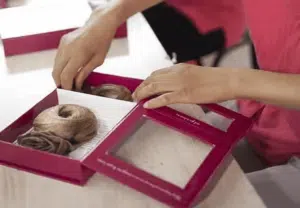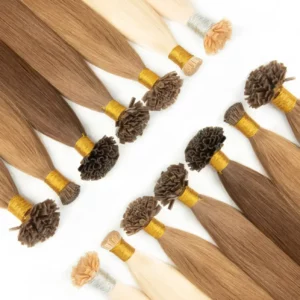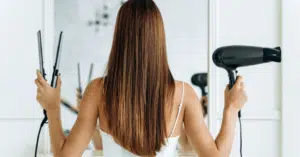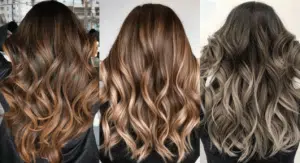After 2-3months,clients return with grow-out and sticky roots. Teams feel rushed. We fix this with a clean, repeatable rebond workflow that protects hair and margins.
The correct way to rebond tape hair extensions is: remove with approved solvent, deep-clean wefts and natural hair, dry to zero residue, apply fresh professional tape tabs, and reinstall with precise sectioning and pressure. Follow timing, grams, and aftercare to prevent slippage and breakage.

Stay with us. We lay out chair-ready steps, tool lists, drying rules, tape choices, QA checks, risk controls, and pricing signals—so U run fast, clean, and consistent appointments.
How to remove tape in extensions?
Removals often go wrong from speed or the wrong solvent.
Use the correct remover, respect dwell time, and peel with control. Protect cuticles, keep sections clean, and avoid root torsion.
We remove tape-in extensions by applying an approved citrus or alcohol-based solvent, allowing dwell time, and separating the sandwiches with zero force. We wipe adhesive off each tab, then cleanse the natural hair until it is oil- and residue-free. We never scrape with metal against the scalp.
Tools and Setup
- Remover: brand-approved solvent (keep both fast-evap and slow-evap on the tray).
- Tools: tail combs, clips, lint-free pads, sectioning clips, disposable caps, microfibre towels.
- PPE: nitrile gloves for stylists, cape for clients.
- Waste: adhesive-safe bin liners.
Step-by-Step with Risk Control
- Map and photograph rows before removal for a re-install roadmap.
- Apply solvent along the bond edges; saturate the internal seam.
- Wait 30–90 seconds (follow brand). Rushing traps residue.
- Pinch open the seam with pads or the flat side of a comb; never yank.
- Work from ends to the center to reduce torsion at roots.
- Detach upper tab, then the lower, supporting natural hair with the other hand.
- Remove adhesive film left on strands using more solvent + gentle pinch-wipe.
- Comb out softened adhesive from mid-lengths; keep comb strokes parallel to hair.
- Shampoo the natural hair with a clarifying formula once now (a deeper cleanse comes later).
- Dry to damp and park the client under a cap while U clean wefts.
Red Flags
- White sticky pilling on strands = not enough dwell time.
- Squeaky resistance when separating = pause, re-saturate, wait.
- Any scalp pull = stop and re-angle your pinch. Protect roots first.
| Item | Use | Pro Tip |
|---|---|---|
| Fast-evap remover | Quick bond release | Great for fine hairlines |
| Slow-evap remover | Heavy residue melts | Ideal for dense sandwiches |
| Lint-free pads | Wipe adhesive safely | Swap pads often to avoid smearing |
How to clean and re tape extensions?
Dirty tabs cause slippage, odor, and short cycles.
We clean each weft to “zero residue,” then dry fully before re-taping. No shortcuts. Dry, clean surfaces bond strongest.
We degum old adhesive from the weft tops with remover, a silicone-safe scraper, and lint-free pads. We clarify the hair lengths twice, rinse thoroughly, and dry until the tab area is crisp and non-tacky. Only then do we apply new professional tape tabs.
Bench Workflow
- Strip old tape: bend the tab slightly, lift a corner with a plastic spatula, and peel slowly while adding remover.
- Degum: lay the weft on a pad; flood with remover; glide adhesive off in one direction.
- Clarify lengths: shampoo twice; avoid conditioners or oils anywhere near the tab zone.
- Rinse and blot: rinse long; blot with microfibre to pull residues from cuticles.
- Drying rules: blow-dry from roots-to-tab side with medium heat until bone-dry. Any moisture kills bond strength.
Surface Quality Test
- Touch test: tab area should squeak under a glove, not stick.
- Visual: no cloudy film, no stringing adhesive.
- Tape adherence test: press a test tab, then peel; resistance should be firm and even.
Common Errors and Fixes
- Still tacky tab base → repeat degum + a final isopropyl wipe, then dry again.
- Slippage in a week → likely moisture or oil at install; review drying and client products.
- Odor → incomplete rinse/clarify; extend rinse time and use fresh towels.
| Step | Minimum Time | Fail Mode if Skipped |
|---|---|---|
| Degum old adhesive | 10–20 min per full set | Residual film, weak rebond |
| Double clarify | 2 full washes | Slip, odor, “gummy” feel |
| 100% dry tab zone | Until cool/dry to touch | Early lift, corner peel |
How to put new tape on tape in extensions?
The rebond is only as strong as your prep and pressure.
We align, press, and cure correctly. We avoid finger oils and ensure edge-to-edge coverage without overhang.
We apply fresh, salon-grade tape tabs to fully dry, residue-free weft tops. We place tabs flush to edges, avoid overlap, and press with a roller or clamp for uniform adhesion. We allow the adhesive to “set” per brand guidance before re-install.
Tab Selection and Handling
- Adhesive grade: salon-grade, medical-grade options for sensitive clients.
- Width: match your weft width; avoid trimming the adhesive unless brand allows.
- Storage: keep tabs sealed, away from heat/sun; discard dusty or curled tabs.
- Handling: use tweezers; avoid touching adhesive with bare fingers.
Application Steps
- Place weft tab-side up on a clean board.
- Align new tape flush with the top; no overhang or gaps.
- Press with a silicone roller 5–10 seconds; repeat end-to-end.
- Optional pre-cure: some brands recommend a 10–15 minute set time before install.
- Stack pairs for sandwiches, adhesive facing out for the final bond.
Quality Controls
- Edge check: corners seated and sealed; no lifting.
- Peel test: controlled peel shows even resistance.
- Inventory log: batch numbers recorded to trace any adhesive issues.
| Variable | Best Practice | Outcome |
|---|---|---|
| Pressure | Roller or clamp, uniform | Even bond strength |
| Temperature | Room temp, low humidity | Fewer micro-bubbles |
| Set time | Follow brand (10–15 min) | Stable early wear |
How to reinstall after re-tape for maximum hold?
Reinstalls fail from wet roots, oil, or poor sectioning.
We section clean, place with the right gap from scalp, apply even pressure, and educate clients on product zones.
We reinstall on clarified, 100% dry natural hair. We keep 1–1.5 cm off the scalp to allow movement. We use sandwich or single-sided methods by density. We press and seal evenly, then finish with blending and aftercare coaching.
Placement Rules
- Distance: 1–1.5 cm from scalp; too close = pinch and lift.
- Density match: fine hair → lighter grams and single-sided tabs; dense hair → standard sandwiches.
- Direction: follow natural fall; avoid crossing cowlicks and swirls.
Pressing and Sealing
- Place lower tab under the section; lay natural hair evenly (no cross hairs).
- Place upper tab; align edges perfectly.
- Press by hand, then use a pressing tool or warm (brand-permitted) clamp for 3–5 seconds.
- Cool before combing or heat styling.
Immediate Aftercare Script
- 48 hours: no washing, saunas, or heavy sweating.
- Products: oils, conditioners, and masks start mid-length to ends—never at bonds.
- Drying: fully dry bonds after workouts and showers.
| Area | Do | Don’t |
|---|---|---|
| Sectioning | Clean, parallel | Diagonals that twist bonds |
| Bond Zone | Keep oil-free | Serums at the roots |
| Weight | Match grams to client | Overload fine hair |
How to prevent residue and stickiness after removal?
Sticky roots kill client trust.
We solve stickiness with more dwell time, correct solvent, patient wiping, and double clarification. We never rush.
We saturate, wait, and wipe in one direction. We repeat until strands glide. We clarify twice and rinse long. We blow-dry root zones fully before any re-tape. We track which tape batches resist removal and switch suppliers if needed.
Dive deeper Paragraph
Root-Zone Protocol
- Saturate bonds until glossy; cap for 2–3 minutes if heavy.
- Open seams with pads; slide adhesive off the hair, not through it.
- Use a plastic spatula at the tab only—never on the scalp.
- Comb with solvent from mid to ends in parallel strokes.
- Clarify twice; massage scalp but avoid scratching.
- Dry to zero moisture; check by feel and mirror.
Supplier and Product Notes
- If residue persists across clients, test alternative removers.
- Consider hypoallergenic tapes for sensitive clients; they often release cleaner.
- Record lot numbers; quality swings happen batch to batch.
| Residue Type | Cause | Fix |
|---|---|---|
| Stringy glue | Short dwell time | Re-saturate + wait |
| Cloudy film | Poor rinse | Longer rinse + isopropyl wipe |
| Tacky roots | Product near bonds | Client product audit + education |
How to choose tapes, removers, and tools for your salon?
Wrong materials increase callbacks.
We match adhesives to hair density, scalp sensitivity, climate, and service speed. We stock two removers and log lot numbers.
Tapes
- Standard hold: balanced tack for most clients; 6–8 week cycles.
- Extra hold: humid climates or oily scalps; requires stricter removal.
- Hypoallergenic: sensitive scalps; usually cleaner release, slightly shorter cycles.
Removers
- Fast-evap: detail work near hairline, fine hair clients.
- Slow-evap: heavy residue, dense sandwiches, back-of-head zones.
Tools
- Silicone roller/press, plastic spatulas, section clips, tail combs, microfibre towels, cap, heat tool (only if brand allows warm seal), lint-free pads.
| Category | Option | When to Use |
|---|---|---|
| Tape | Standard | Most clients/temperate climates |
| Tape | Extra Hold | High humidity/oily scalps |
| Tape | Hypoallergenic | Sensitive/scalp-prone clients |
| Remover | Fast-Evap | Hairlines/fine density |
| Remover | Slow-Evap | Heavy residue/back sections |
How to price, schedule, and communicate rebond services?
Clear scripts protect margins and rebooking.
We price by grams + rows + stylist level. We pre-book move-ups and set rules for product zones, gym, and sauna behavior.
Pricing Model
- Base fee (removal + deep clean)
- Re-tape materials (tabs by pack)
- Reinstall fee (rows/time + stylist tier)
- Optional: bond upgrade (hypoallergenic/extrahold), express dry fee
Scheduling
- New sets: 90–150 minutes depending on density.
- Rebond cycles: 60–120 minutes; add time for heavy residue.
- Move-up cadence: 6–10 weeks; set the next appointment before checkout.
Client Script (handout-ready)
- “Keep oils and conditioners mid-length to ends.”
- “Dry bonds after workouts.”
- “No washing for 48 hours post re-install.”
- “Bring your care card if issues occur—faster triage.”
| Line Item | Why It Matters |
|---|---|
| Materials line | Transparent costs stop haggling |
| Tiered labor | Rewards skill and speed |
| Pre-booking | Locks retention and reduces emergency calls |
My opinion
U run rebonds like surgery: solvent patience, zero-residue cleaning, and strict drying. U stock two remover types and three tape grades. U log batches and photos. U price by grams and rows, not guesses. U win because installs stay flat, bonds hold full cycle, and clients rebook on schedule with trust.
FAQ
What’s the biggest cause of early tape slippage after rebond?
Moisture or oil at install. Fix with double clarification, 100% dry roots and tabs, no conditioners near bonds, and proper pressure/setting time.
Can we reuse the same tapes?
No. Always use fresh, professional tabs. Old adhesive loses uniform tack and contaminates bonds.
How long should clients wait before washing after re-install?
48 hours. They should avoid heavy sweating, saunas, and hats that trap heat and moisture during that window.
Which remover is gentlest for fine hairlines?
Fast-evap removers with targeted application. Use pads and patience. Never pry with metal near skin.
How many rebond cycles can quality hair handle?
With full cuticle, single-donor human hair and correct care, many clients enjoy multiple cycles across 1–2 years. Monitor cuticle feel and trim ends as needed.
Do hypoallergenic tapes last as long as standard tapes?
Usually slightly shorter, but they release cleaner and are kinder to sensitive scalps. Choose based on client history and climate.
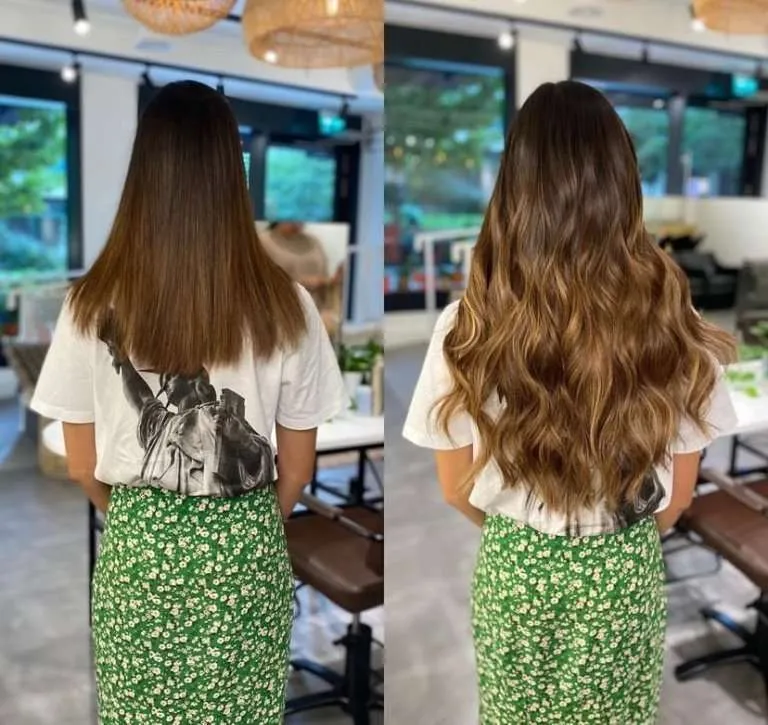
Conclusion
Rebond right: patient solvent removal, zero-residue cleaning, full drying, fresh tabs, precise pressure, and clear aftercare. Do this, and bonds stay flat, clients stay loyal, and margins hold.
Hibiscus Hair Manufacturer has been dedicated to producing high-quality hair extensions for 25 years and is a recognized leader in the industry. If you are interested in finding a reliable hair extensions supplier and wholesale for your brand, please visit our website for more information:
TAPE IN HAIR

